The Cantareira System region covers about 230 thousand hectares. Water reservoirs occupy only 5% of this territory. Can you imagine the amount of rainwater that could enter the Cantareira System if it met the conditions to infiltrate the soil?
The most appropriate place to store rainwater is underground or at the water table. When this happens, water is gradually released until it reaches the reservoirs. Therefore, increasing water security.
However, in most of the Cantareira System soil, which is degraded, rainwater flows over the surface, carrying earth and nutrients in an excessive and uncontrolled way into the reservoirs. Although we may have the impression that this is a good scenario, this situation worsens the water quality and impoverishes the soil even more.


Climate changes influence the region’s rains and droughts
Climate change is also an aggravating factor in the region as it makes the rainfall regime more uncertain, varying between long periods of drought and heavy rains concentrated in short periods. This scenario will affect rural producers and those who depend on this water in large centers. The reservoir will face prolonged periods of flooding and periods of water scarcity when the stability provided by the natural supply of groundwater would be desirable.
For this reason, the Sowing Water project works to reforest the region where the Cantareira System is. Aiming to educate rural producers, companies, and the population in the surroundings and areas supplied by the System about the importance of land use for water security.

